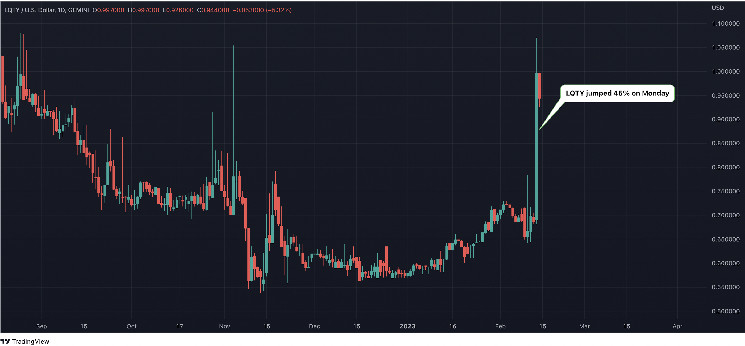LQTY, the native token of censorship-resistant decentralized stablecoin lender Liquity, surged Monday after a New York regulator ordered Paxos to stop minting its centralized dollar-pegged cryptocurrency BUSD.
The token rose 45% to a six-month high of $1.07, registering its biggest single-day percentage gain in at least a year, per data sourced from the charting platform TradingView.
The rally likely stemmed from the Paxos-BUSD drama that triggered fears of a regulatory crackdown on the broader centralized stablecoin ecosystem, including Circle's USDC and underscored the need for decentralized and censorship-resistant stablecoins like Liquity's LUSD.
"BUSD proves the need for decentralized and censorship-resistant stablecoins. This is indeed the mission of Maker and Liquity's LUSD. Maker's Endgame Plan foresees a regulatory crackdown on crypto and RWAs, so it's preparing to make DAI censorship resistant. The same mission drives LUSD stablecoin, but its approach is focused on minimal governance and ETH as the only collateral," pseudonymous DeFi researcher Ignas told CoinDesk.
Liquity is an Ethereum-based protocol offering interest-free loans against a minimum of 110% collateral in ether (ETH). The loans are paid out in the form of a dollar-pegged stablecoin LUSD and borrowers only need to pay a small loan generation free. The redemption and loan issuance fees are adjusted algorithmically. The LQTY is a reward token created by the protocol to incentivize users, frontends and stability providers – the first line of defense in maintaining system solvency.
The protocol runs a two-token model like MakerDAO. The difference, however, is that Liquity doesn't have a governance system. Therefore, large holders of LQTY cannot influence decision-making. The fully-decentralized setup also means the protocol's original design cannot be altered to introduce centralized stablecoins, which have recently come under regulatory scrutiny, as new collateral.
More importantly, Liquity doesn't run its own web interface, and its smart contracts can be accessed via multiple third-party front ends. "As a company, Liquity AG is not running its own frontend — making the system more decentralized and censorship-resistant. To open loans, make deposits etc., users thus have to use one of the frontends provided by third parties," the official website says.
These features make Liquity's LUSD censorship-resistant and provide the protocol an edge over MakerDAO. Hence, its no surprise that some traders consider LQTY and not MakerDAO's MKR token as a refuge against the regulatory crackdown.
"LUSD backed by ETH collateral is being perceived as more defensible against regulatory pressure by the market," Lewis Harland, portfolio manager at Decentral Park Capital, said.
The renewed bias for decentralized crypto-backed stablecoins is evidence of fasting changing narratives in the crypto market. These coins had fallen out of favor in May last year following the dramatic collapse of Terra's algorithmic decentralized stablecoin UST.
While LQTY surged over 40% on Monday, MKR rose 12% and Tron's TRX rose 3%. Tron, a smart contract platform supposedly maintaining true decentralization and censorship resistance, unveiled a decentralized dollar-pegged stablecoin USDD last year.
Crypto Twitter is optimistic that Liquity and other protocols offering decentralized stablecoins will continue to shine if the regulatory crackdown on centralized dollar-pegged coins intensifies.
"I see no reason why $LUSD won’t return to a +1B market cap again, especially with Gensler acting like a child with a handgun. $LQTY is my favorite mid-term play," one DeFi investor tweeted.
Learn more about Consensus 2023, CoinDesk’s longest-running and most influential event that brings together all sides of crypto, blockchain and Web3. Head to consensus.coindesk.com to register and buy your pass now.
 coindesk.com
coindesk.com
